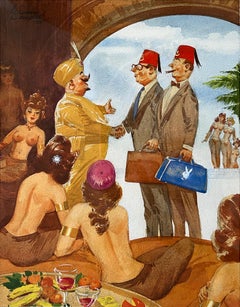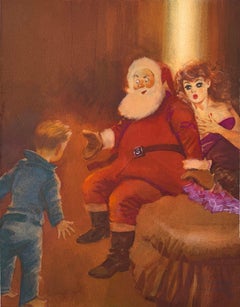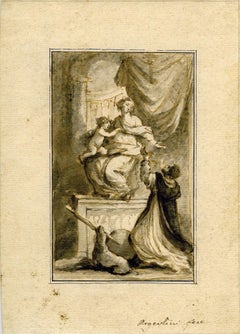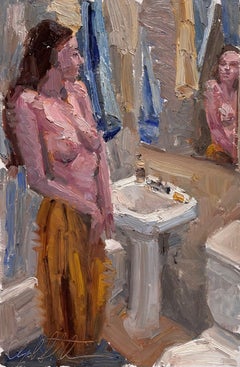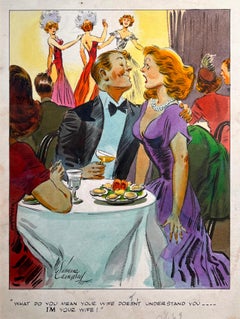E. Simms Campbell Figurative Paintings
American, 1906-1971
Elmer Simms Campbell (January 2, 1906 – January 27, 1971) was an American commercial artist best known as the cartoonist who signed his work, E. Simms Campbell. The first African-American cartoonist published in nationally distributed, slick magazines, he created Esky,the familiar pop-eyed mascot of Esquire. Campbell was born in St. Louis, Missouri, the son of educators, Elizabeth Simms Campbell & Elmer Campbell
He then enrolled in the University of Chicago. After one year, Campbell left the University of Chicago and transferred to and received his degree from the Chicago Art Institute.
He spent two years at Triad Studios before moving to New York City in 1929. taking classes at the National Academy of Design. During this time, he contributed to various magazines, notably Life, & Judge.
Following the suggestion of cartoonist Russell Patterson to focus on good girl art, Campbell created his "Harem Girls", a series of watercolor cartoons that attracted attention in the first issue of Esquire, debuting in 1933. Campbell's artwork was in almost every issue of Esquire from 1933 to 1958 & he was the creator of its continuing mascot, the cartoon character in a silk top hat.
He also contributed to The Chicagoan, Cosmopolitan, Ebony, The New Yorker, Playboy, Opportunity: A Journal of Negro Life, Pictorial Review, and Redbook.
His commercial artwork for advertising included illustrations for Barbasol, Springmaid,Hart Schaffner & Marx.
Campbell also was the author of a chapter on blues music in the 1939 book Jazzmen, a seminal study of jazz's history and development.
Campbell died in White Plains, New York, in 1971
His gag panel, Cuties, was syndicated by King Features in more than 145 newspapers "A Night-Club Map of 1930s Harlem"
Of enduring cultural & historical interest is the witty, cartoon-filled map Campbell drew in 1932 – "A Night-Club Map of 1930s Harlem" identifying the attractions of Harlem during the Harlem Renaissance and adding his personal notes. He captures the intensity of the scene: within a few blocks of each other he has cartooned Cab Calloway singing at the Cotton Club, Bill "Bojangles" Robinson doing his step dance at the Lafayette Theater – "Friday night is the Midnight show, Most Negro revues begin and end here." Lissome "cafe au lait girls" dance at Small's Paradise. Outside, doormen welcome White swells in top hats, while an elegant Black couple in evening dress dance "the Bump"
Campbell's map appears in the book version of Ken Burns's documentary Jazz. The map in its entirety also appears as the inside front cover of "Of Minnie the Moocher and Me", the autobiography of Cab Calloway by Cab Calloway and Bryant Rollins (TY Crowell, 1976). Jazz historian Mike Thibault reports that the original was displayed by the Smithsonian in 1996.The map is currently held at the Yale Beinecke Rare Book & Manuscript Library.
On April 4, 2017, National Geographic published an article on the map that included the map and several enlarged sections of it. They featured it again during 2020 to subscribers of their newsletter, among a collection of unique maps of New York City.
Recognitionto
2
Overall Width
to
Overall Height
to
2
2
1
2
2
2
2
1
1
1
1
2
2
2
1
1
6
467
324
258
226
2
Artist: E. Simms Campbell
Beautiful Maidens Nude Women Harem, Playboy Cartoon African American Illustrator
By E. Simms Campbell
Located in Miami, FL
E. Simms Campbel was the first major African American Illustrator. He did covers for Esquire Magazine starting in the 1930s.
He created the famous bulging-eyed Esquire Mascot “Esky.”
He also worked for The Chicagoan, Cosmopolitan, Ebony, The New Yorker, Playboy, Opportunity: A Journal of Negro Life, Pictorial Review, and Redbook.
This work, "What do you mean your wife doesn't understand you ---- I'm your wife!" is from Cuties Daily Comic Strip, June 18, 1950
He was inducted into the Society of Illustrators' Hall of Fame in 2002.
His work demonstrates a deep and masterfully understanding of drawing figures and faces in an academic but stylized style.
"My pleasure, boys. Always glad to see a delegation from the States." From the Playboy Collection...
Category
1960s Impressionist E. Simms Campbell Figurative Paintings
Materials
Watercolor, Pencil
Santa Claus Sexy Playboy Cartoon First African American Illustrator, Elmer Simms
By E. Simms Campbell
Located in Miami, FL
Santa has a quickie with Mom.
Elmer Simms Campbell was the first African American Illustrator to work for major newsstand magazines.
Published December, 1963
Signed in pencil lower...
Category
1960s Realist E. Simms Campbell Figurative Paintings
Materials
Watercolor, Illustration Board, Pencil
Related Items
Neoclassical composition of a sculptor kneeling before his statue of the Madonna
Located in Middletown, NY
An allegory of loyalty, with the subject's dog pictured seated, holding his master's chisel in his mouth; fidelity personified.
Italian School, 18th century
Ink wash in gray and bl...
Category
Mid-18th Century Italian School E. Simms Campbell Figurative Paintings
Materials
Laid Paper, Ink, Watercolor
$500
H 9.73 in W 7.01 in
"Annunciation" Oil Painting
Located in Denver, CO
Clyde Steadman's "Annunciation" is an original, handmade oil painting that depicts an impasto painting of a nude female model in an interior bathroom setting.
Category
2010s American Impressionist E. Simms Campbell Figurative Paintings
Materials
Oil, Panel
Early 20th Century Young Golfer Figurative
By Margaret Neilson
Located in Soquel, CA
Study of a young man with his golf clubs by listed artist Margaret Neilson Armstrong (American, 1867-1944). Image, 14"H x 20"W. Displayed in vintage mat. S...
Category
1920s Realist E. Simms Campbell Figurative Paintings
Materials
Paper, Pencil
"Bathsheba" Oil Painting
Located in Denver, CO
Clyde Steadman's "Bathsheba" is an original, handmade oil painting that depicts an impasto painting of a nude female model in an interior setting.
Category
2010s American Impressionist E. Simms Campbell Figurative Paintings
Materials
Oil, Panel
Untitled (Abstract Male Reclining Nude)
By Ian Hornak
Located in Fairfield, CT
Artist: Ian Hornak (1944-2002)
Title: Untitled (Abstract Male Reclining Nude)
Year: 1963
Medium: Watercolor on heavy archival paper
Size: 29.5 x 21 inches
Condition: Good
Provenance:...
Category
1960s Impressionist E. Simms Campbell Figurative Paintings
Materials
Watercolor
French Impressionist Nude Female Posed Figure Pencil Sketch Painting
Located in Cirencester, Gloucestershire
Nude Female
by Louise Alix (French, 1888-1980) *see notes below
provenance stamp to the back
pencil drawing on artist paper, unframed
measures: 8 high by 10 inches wide
condition: o...
Category
Mid-20th Century Impressionist E. Simms Campbell Figurative Paintings
Materials
Color Pencil
$557 Sale Price
30% Off
H 8 in W 10 in
Illuminated
By John McLeod
Located in Denver, CO
Nude figure with candlelight
Category
2010s American Impressionist E. Simms Campbell Figurative Paintings
Materials
Oil
Study of a Seated Figure from Behind Pencil Sketch
Located in Cirencester, Gloucestershire
Study of a Seated Figure
pencil drawing on artist paper
painting: 11 x 8.25 inches
double sided
provenance: private collection, England
condition: very good and sound condition
Category
20th Century Impressionist E. Simms Campbell Figurative Paintings
Materials
Pencil
$92 Sale Price
30% Off
H 11 in W 8.25 in D 1 in
French Impressionist Posed Nude Female Figure Pencil Sketch
Located in Cirencester, Gloucestershire
Female Nude Figure
by Louise Alix (French, 1888-1980) *see notes below
provenance stamp to the back
pencil drawing on artist paper, unframed
measures: 10 high by 8 inches wide
condi...
Category
Mid-20th Century Impressionist E. Simms Campbell Figurative Paintings
Materials
Color Pencil
$557 Sale Price
30% Off
H 10 in W 8 in
1950s French Post Impressionist Painting Nude Model in Parisian Interior
By Josine Vignon
Located in Cirencester, Gloucestershire
Josine Vignon (French 1922-2022) ...
Category
Mid-20th Century Impressionist E. Simms Campbell Figurative Paintings
Materials
Gouache
$515 Sale Price
30% Off
H 14.5 in W 16.5 in D 1 in
Self Portrait 02 - Modern Figurative Watercolor Painting, New Expressionism
By Maciej Olekszy
Located in Salzburg, AT
The artwork on paper will be sent unframed to you.
Maciej Olekszy was born in 1982, Poland. Graduated from the Academy of Fine Arts in Poznan, Poland in 2007. Faculty of Painting i...
Category
2010s Contemporary E. Simms Campbell Figurative Paintings
Materials
Paper, Watercolor
$1,412
H 41.34 in W 29.53 in
Clemente Pujol de Gustavino An orientalist Arab Guardsman
Located in New York, NY
Artist: Clemente Pujol de Guastavino (1850-1905)
Origin: Spanish
Signature: signed C. Pujol (lower right)
Medium: oil on canvas
Dimension: 25 1/2 in x 19 3/4 in. Framed 34 by 2...
Category
19th Century E. Simms Campbell Figurative Paintings
Materials
Canvas, Oil
$48,000
H 25.5 in W 19.75 in D 3 in
Previously Available Items
"What do you mean your wife" First African American Illustrator - Black Artist
By E. Simms Campbell
Located in Miami, FL
E. Simms Campbel was the first major African American Illustrator. He did covers for Esquire Magazine starting in the 1930s.
He created the famou...
Category
1950s Academic E. Simms Campbell Figurative Paintings
Materials
Ink, Watercolor, Board
E. Simms Campbell figurative paintings for sale on 1stDibs.
Find a wide variety of authentic E. Simms Campbell figurative paintings available for sale on 1stDibs. You can also browse by medium to find art by E. Simms Campbell in paint, pencil, watercolor and more. Much of the original work by this artist or collective was created during the 1960s and is mostly associated with the Impressionist style. Not every interior allows for large E. Simms Campbell figurative paintings, so small editions measuring 11 inches across are available. Customers who are interested in this artist might also find the work of Ian Hornak, Bernie Fuchs, and Ben Fenske. E. Simms Campbell figurative paintings prices can differ depending upon medium, time period and other attributes. On 1stDibs, the price for these items starts at $22,000 and tops out at $22,000, while the average work can sell for $22,000.
